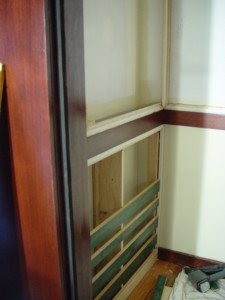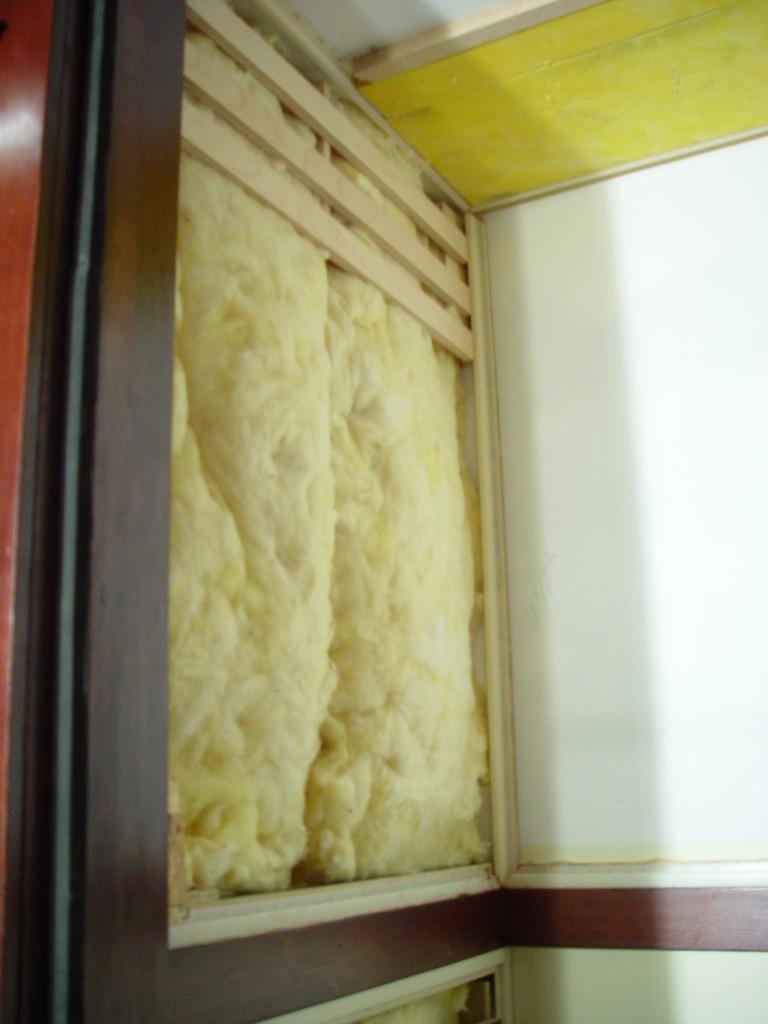Design Considerations for Recording Studios
This article will explore the most important design considerations for Recording Studios. The names and functions of the rooms are; Control Room, the technical hub of the recording process, Studio, the performance area and is also used to describe a facility, Booth refers to a smaller performance space.
All the readers are aware of the common elements these rooms share: line of sight, mechanical systems, isolation, adaptive lighting, connectivity, and so forth. Yet each room is a highly specialized creative environment unique in its function. Let’s start with size and shape.
Size of the room is the dominant acoustic feature. The ratio of the length to width to height will influence regardless of what you may put into the room. Equal dimensions are fatal. A 10’ x 10’ x 10’ room is an anomaly that no audio person should experience. Likewise a repeating dimension, L 16’ x W 10’ x H 10’ is not much better.
A great deal has been written and researched of “golden ratios”. But few people will have the real estate, money and opportunity to build to the inch. There are modal calculators available on the web but they will provide a lot of information that is difficult to understand. R. H. Bolt developed a simple, easy chart for ratio evaluation. The “Bolt Area” really does work.
Source: F. Alton Everest, Master Handbook of Acoustics.
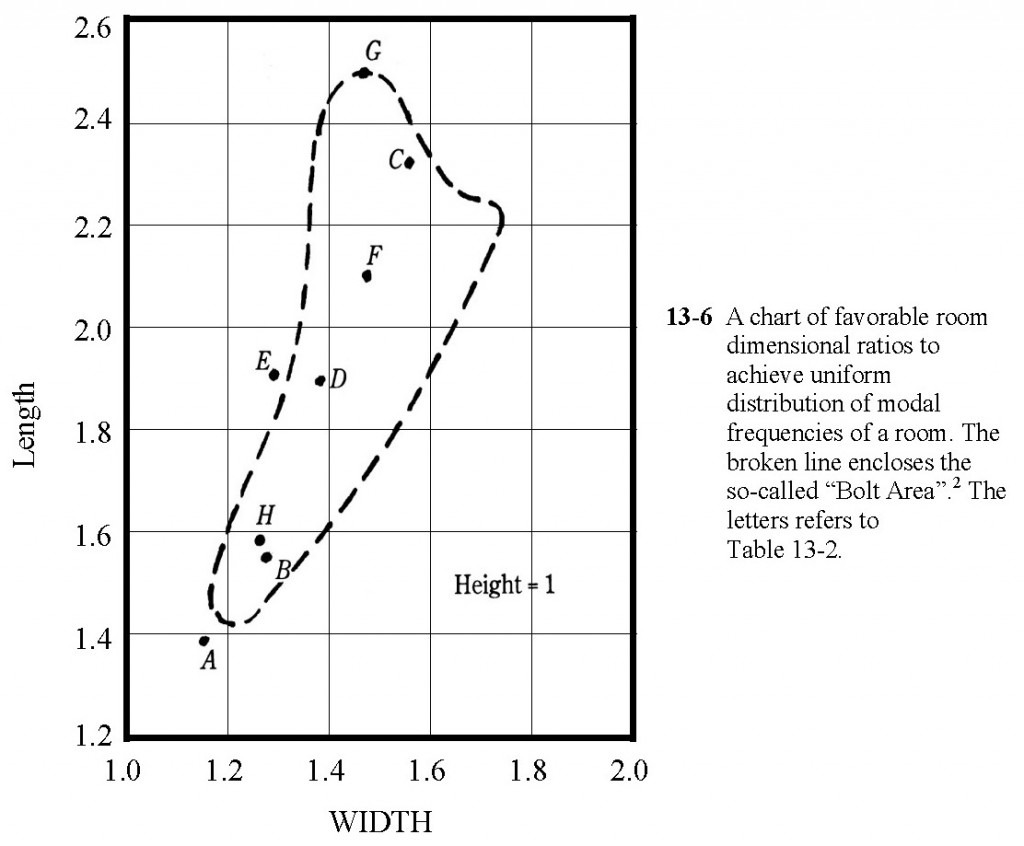
It is easier to deal with poor ratios in larger rooms. audiomachine, Composer 1, has poor ratios. When the room was analyzed it was predicted that in the center of the room there would be no bass with a large diameter of reduced bass. This required a very sophisticated, complex acoustic design. A simple explanation is a variety of absorbers tuned at the floor to ceiling dimension, which represented the area of greatest modal behavior, with completely different treatments front to back. The front of the room has a six-inch absorbent wall, on top of a rigid mass loaded wall. Above the mix position is an 8” absorbent cloud. (Please do not assume these are simple boxes stuffed with mineral wool.) The back wall has hard reflective paneling and wood slats. Directly in the center of the room on the ceiling is an absorption array. The result is a smoother bass response, a large “sweet spot”, and gradual low frequency decay as you move through the room.
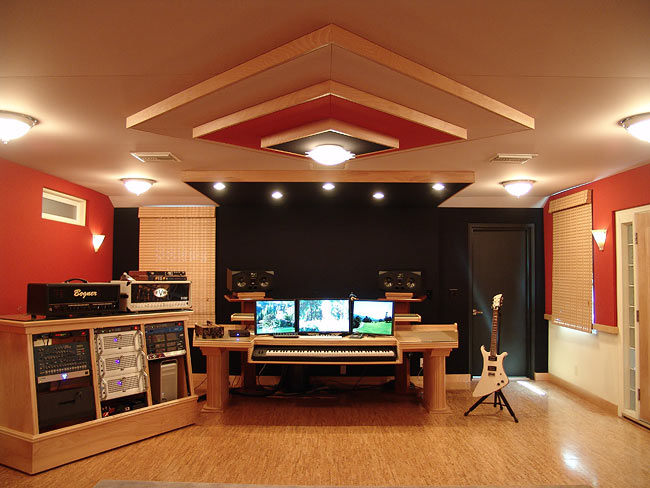
audiomachine, Composer 1 – Front View
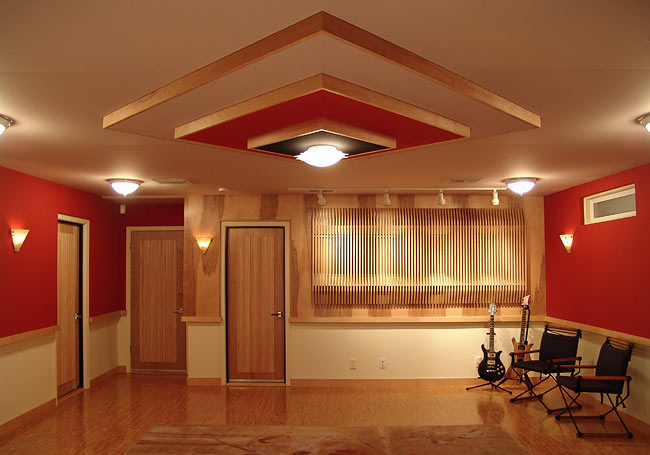
audiomachine, Composer 1 – Rear View
Small booths are exceptionally challenging, even with better ratios. Vocal booths with poor ratios require sophisticated broad band trapping. Pictured below is an example of one wall in a vocal booth with two equal dimensions. The pictures show the framing of the 9” deep absorber, and the uncovered absorber completed. What is not shown is the diaphragmatic membranes and the filled well absorber. The slats on the face help keep some of the high frequency from being absorbed and increase efficiency as reflections are redirected back into the absorber.
|
In progress bottom |
Completed absorber top |
In regards to size, it is difficult to make rooms sound bigger than they are. However reverb times can be extended by adding shape to the boundaries. Nonetheless, usually the size is still detectable to the ear. A tiled bathroom for example has a longer reverb time but still sounds like a tiled bathroom. To make a 150 sq. ft. room sound like a large performance area is not going to happen. This brings us to the next topic.
SHAPE is often misunderstood and mistakenly executed. Contemporary designers would rather have a rectangle with proper ratios for a control room.
“The popularity of rectangle rooms is due part to economy of construction, but it has its acoustical advantages. The axial, tangential, and oblique modes can be calculated with reasonable effort and their distribution studied. For a first approximation, a good approach is to consider only the more dominate axial modes, which is a very simple calculation. Degeneracies (mode pile-ups) can be spotted and other room faults revealed.”
*F. Alton Everest, Master Handbook of Acoustics
So what are the reasons for the shapes you see in a recording studio?
- Many shapes in control rooms are varying depth and types of acoustic treatments. The boundaries are rectangular.
- Shape may be a real advantage for performance rooms. But this is not true for control rooms. Why?
- Control rooms need to be symmetrical, Studios do not.
- Control rooms need to be predictable and accurate. Studios just need to sound good.
- Control Room acoustics require shorter reverb times. Longer reverb is often desired in the “live” room.
- A good control room should sound the same as you move through the room. A large uniform “sweet spot” is desired. A good studio has varying acoustical character throughout the room providing different ambience for recording flexibility.
- Line-of-sight, shape in the studio often provides better eye contact. Control rooms are best when the view is stable at the mix position.
- Often rectangles and squares are divided on the diagonal for efficiency of space. The diagonal line is a longer dimension.
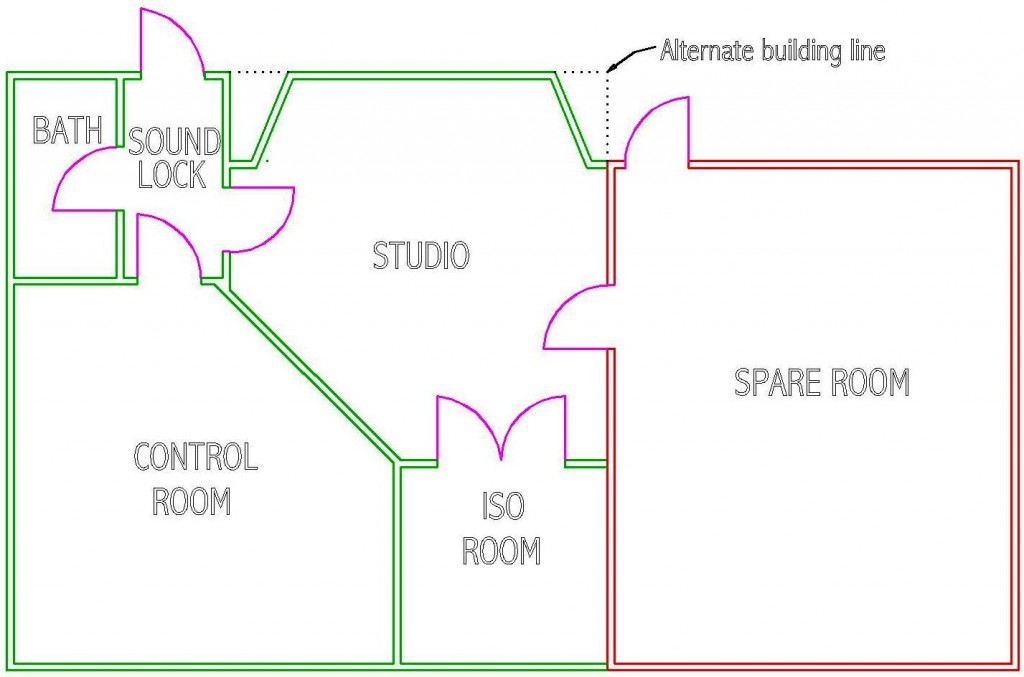
Here is the contradiction….
Project goal:
Restrictions: Cannot move door |
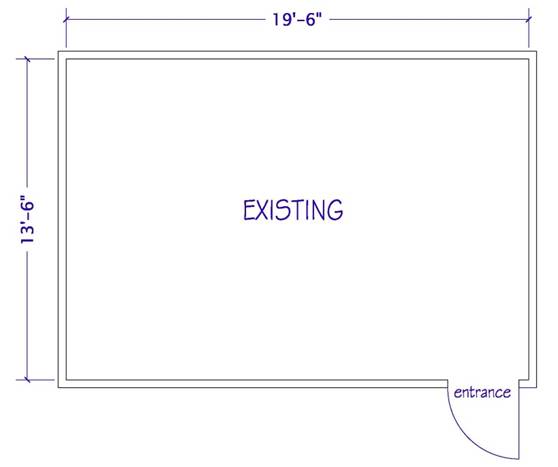 |
We know the soundlock has to be at the front door and allow access to the booth and control room. For the booth to be a usable recording space, 6–7 feet is needed.
Here is the problem illustrated
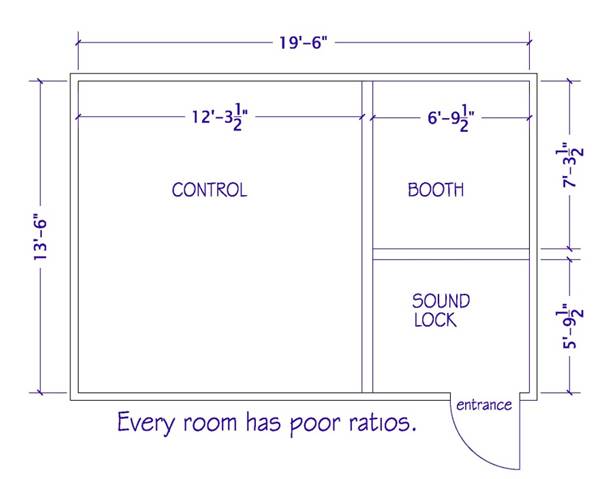
The solution, Angled Walls
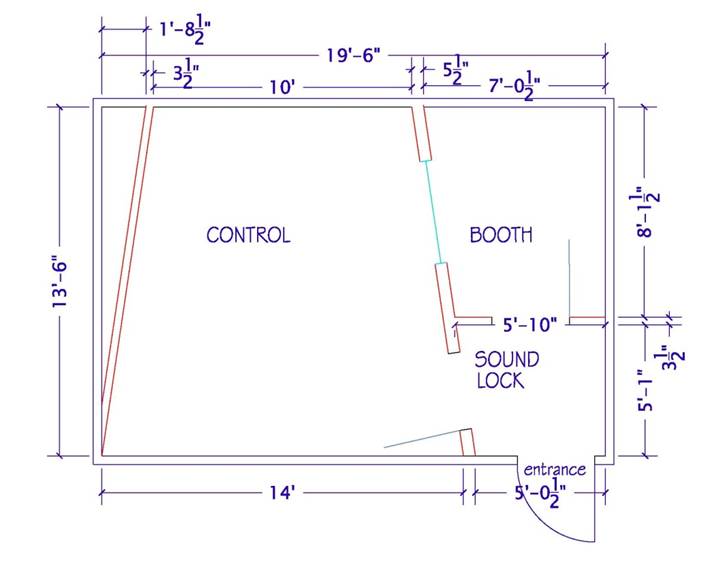
This shape will definitely sound better and sacrifices a minimum amount of space.
The use of splayed walls is neither a mandatory or arbitrary consideration. Common misuse mistakes may result in loss of space, extended or uneven decay times, left to right imbalance, additional unnecessary costs, and strange unintentional consequences.
The ceiling is another place where shape or angles are generally unwanted. Compression ceilings (ceilings angled down towards the listener) were popular in the seventies but a horrible choice for modern control rooms. I apologize if I offended anyone, but someone has to say it. Again, many times the sloped ceilings are acoustic treatments applied to flat boundaries.
There are always exceptions. Large performance rooms with tall ceilings may benefit, but the ceiling should not angle below 12’ anywhere. Beware, it may become an overwhelming characteristic.
Lighting is particularly important and well worth mentioning. There are three definitive tasks lighting must serve in recording studios;
- Full lighting for set-up and cleaning.
- Work lighting, variable for time of day, video screening, different simultaneous tasks i.e., engineering, performing, producing.
- Mood lighting for creative atmosphere.
Because there are windows between each room, the ability to control all lights from the control room is necessary.
STYLES
There are many choices for styles and generally there are code considerations. Styles are easily substituted.
DESCRIPTIONS, as applicable
Control Room At least three lamps, each position, help to minimize shadows.
- Directly over engineering position.
- Work area behind engineer, typically this area will have overdubbing musicians.
- Client area.
- Wall wash / indirect lighting.
- Decorative colored lamps for mood and design.
Performance Area
- Full lighting and work light.
- Surface mount, chandeliers/pendant style for design and function.
- Wall wash / indirect lighting.
- Decorative colored lamps for mood and design.
Special Purpose
RECORDING sign at entrance door
EXIT signs with emergency lighting. The rooms must have sufficient exit light during a power outage, this is aided by glass in doors and between rooms.
Unwanted noise and vibration are a serious concern in all applications. Every decision of style and type must first address unwanted interference and noise.
CONCLUSION
Acoustics and perception are not an intuitive science, made more complicated because there is so much old information out there. References before 1985 are often irrelevant or wrong for today’s production rooms. Vernacular knowledge is in many instances the equivalent to old wives tales. “Angled walls eliminate standing waves”, “cannot have parallel walls”, “build a room inside of a room”, “another layer of drywall is equal to vinyl barrier”, “bass traps are absolutely necessary” are examples of superfluous myths.
I have attempted to be thorough; studio design is a very deep subject. If you are going to build or remodel the use of a professional or consultant is a terrific investment. When building; changes are expensive, mistakes are more expensive, and disappointment is priceless.
I invite everyone to visit our website. There are plans, details, guidelines, links and more valuable information. www.soundcontrolroom.com


